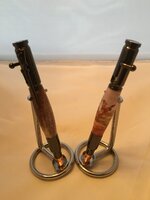flarud
Member
Howdy,, I've only been turning pens for a few months now, I have made a couple hundred mostly plastics. I use sandpaper up to 600 then switch to the wet MM up to 12,000 with no other steps prior to assembly. I stop the lathe between each grit and sand horizontally and by the time I get to 12,000 the blanks look amazing... while still wet. When they dry they still look really good but I would like to have that "wet" look when the pen is assembled. I would think that by using a polish of some sort applied by a rag,, that it would be a step backwards from the 12,000 grit piece of MM. I mean what could be finer than 12,000!? I would rather not use CA as a finish,, I'm not even sure if that would be a step backwards as well. So is there a way to achieve that wet look after sanding to 12,000?
Thanks for any help,
Barry
Thanks for any help,
Barry

